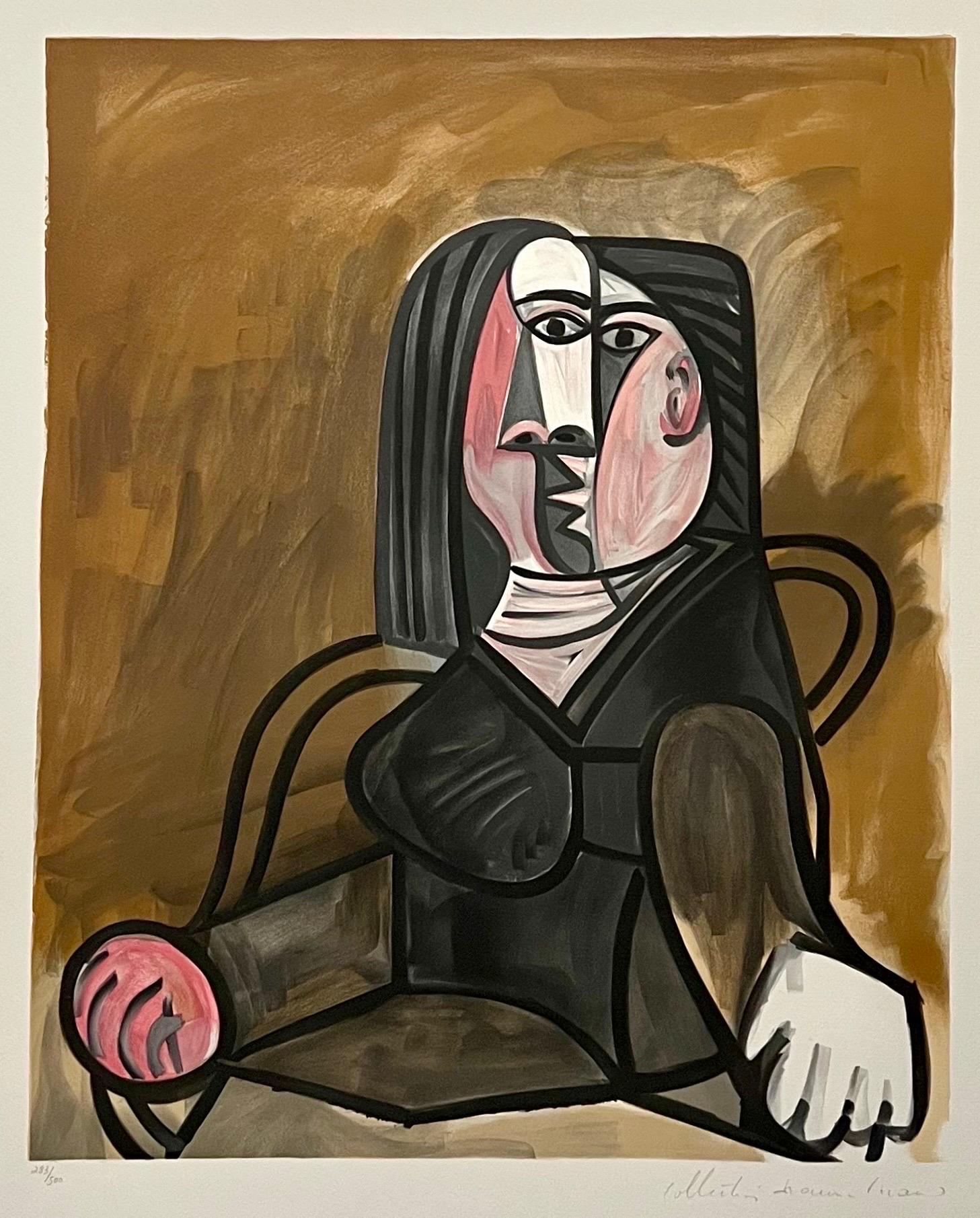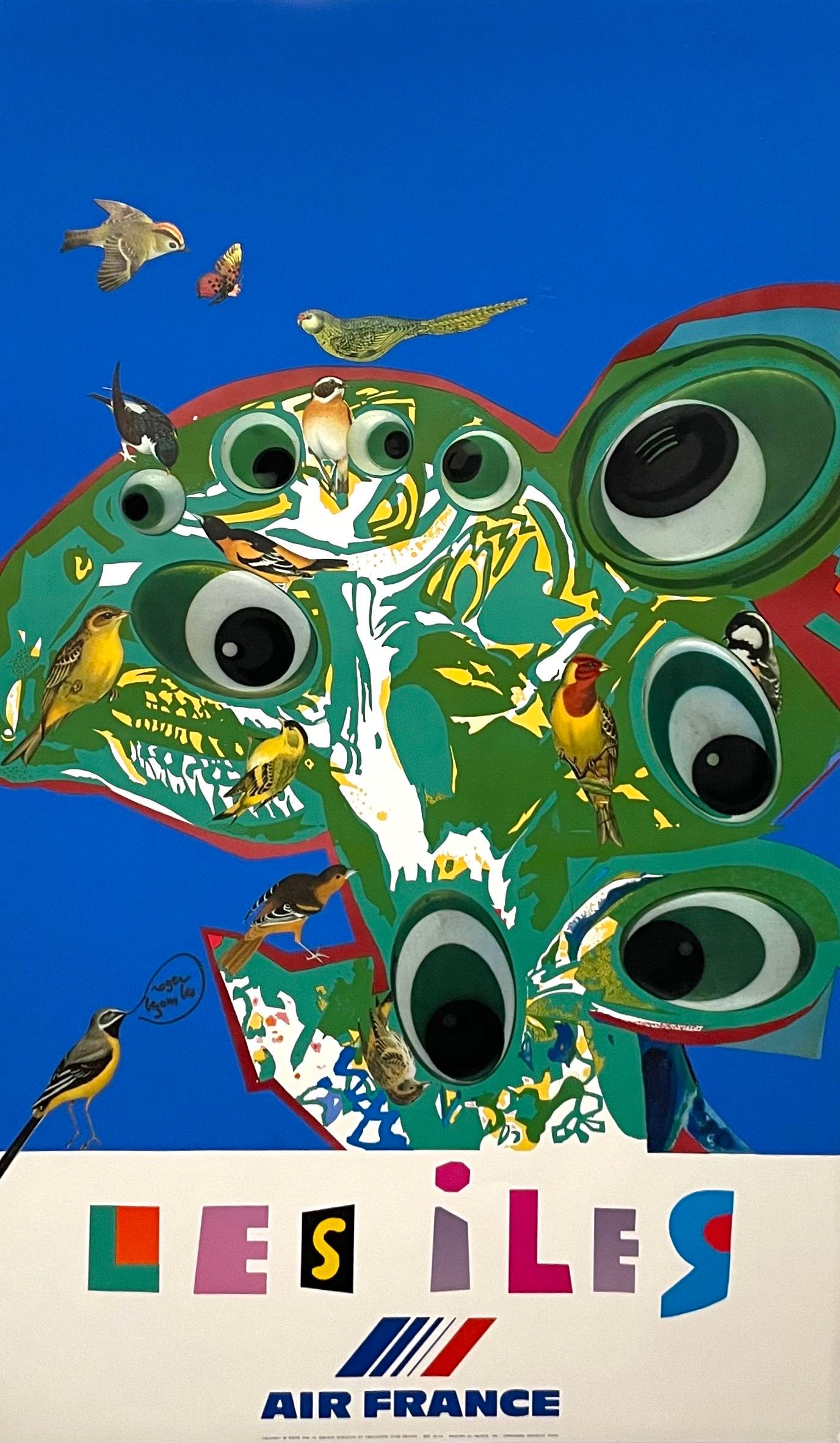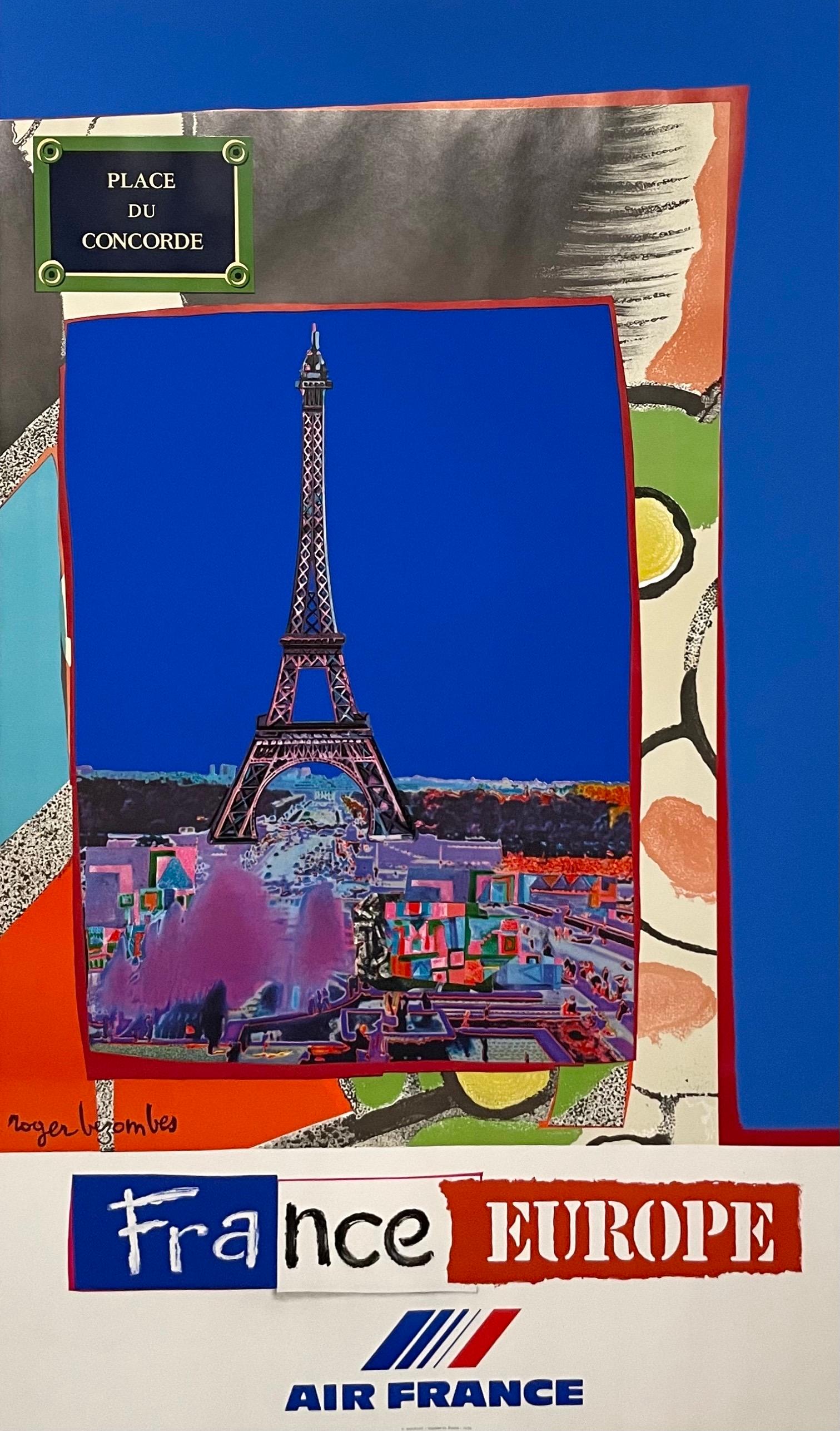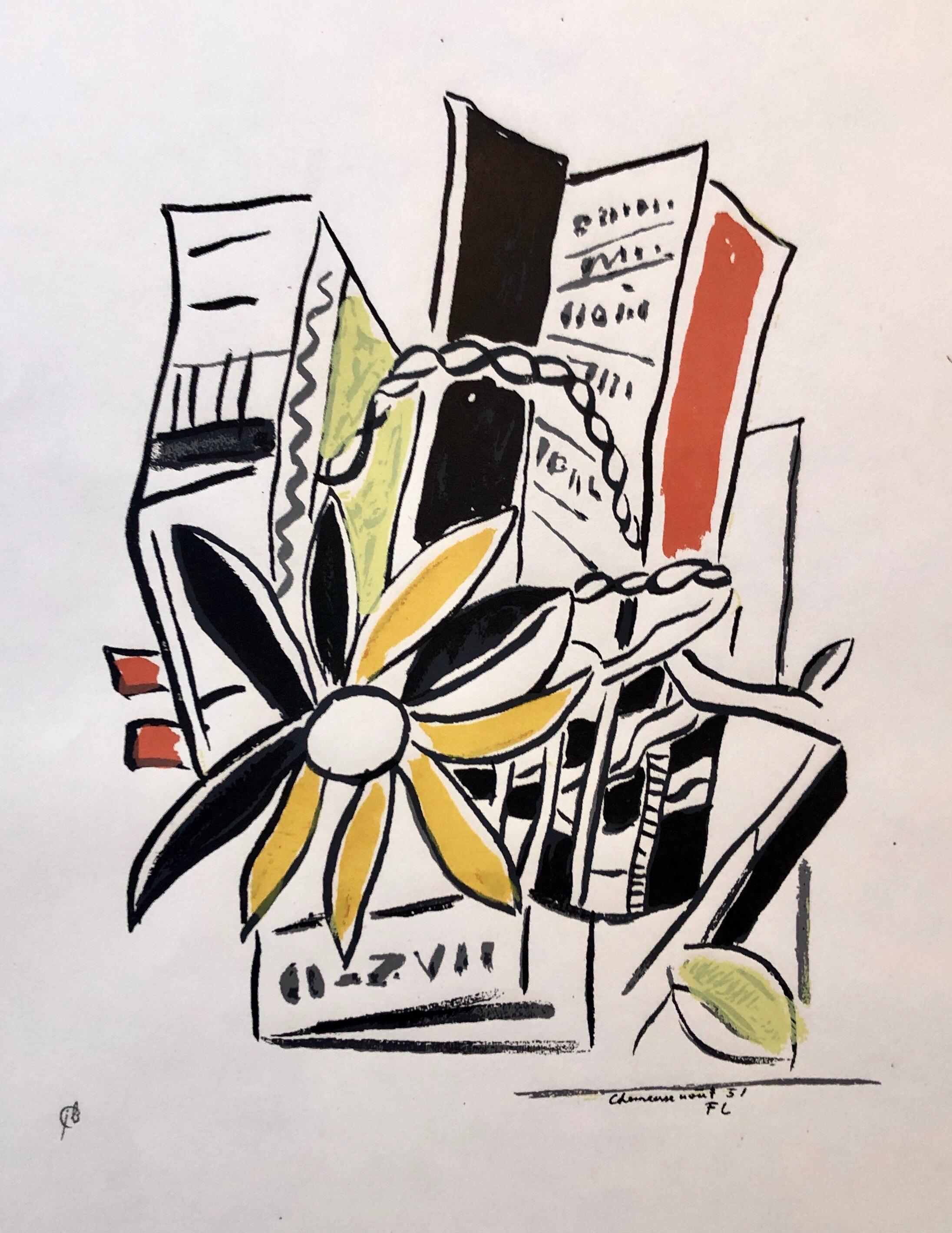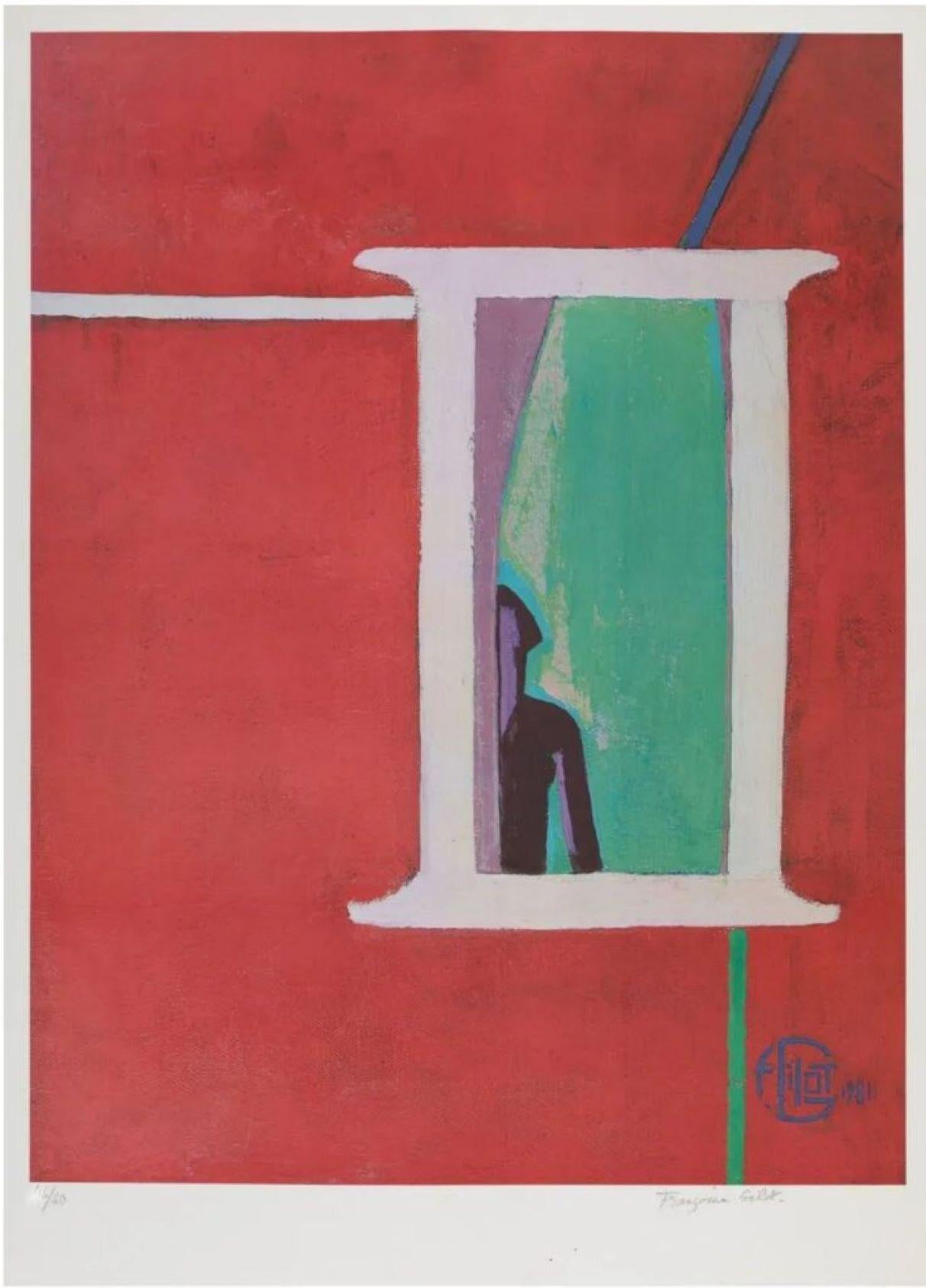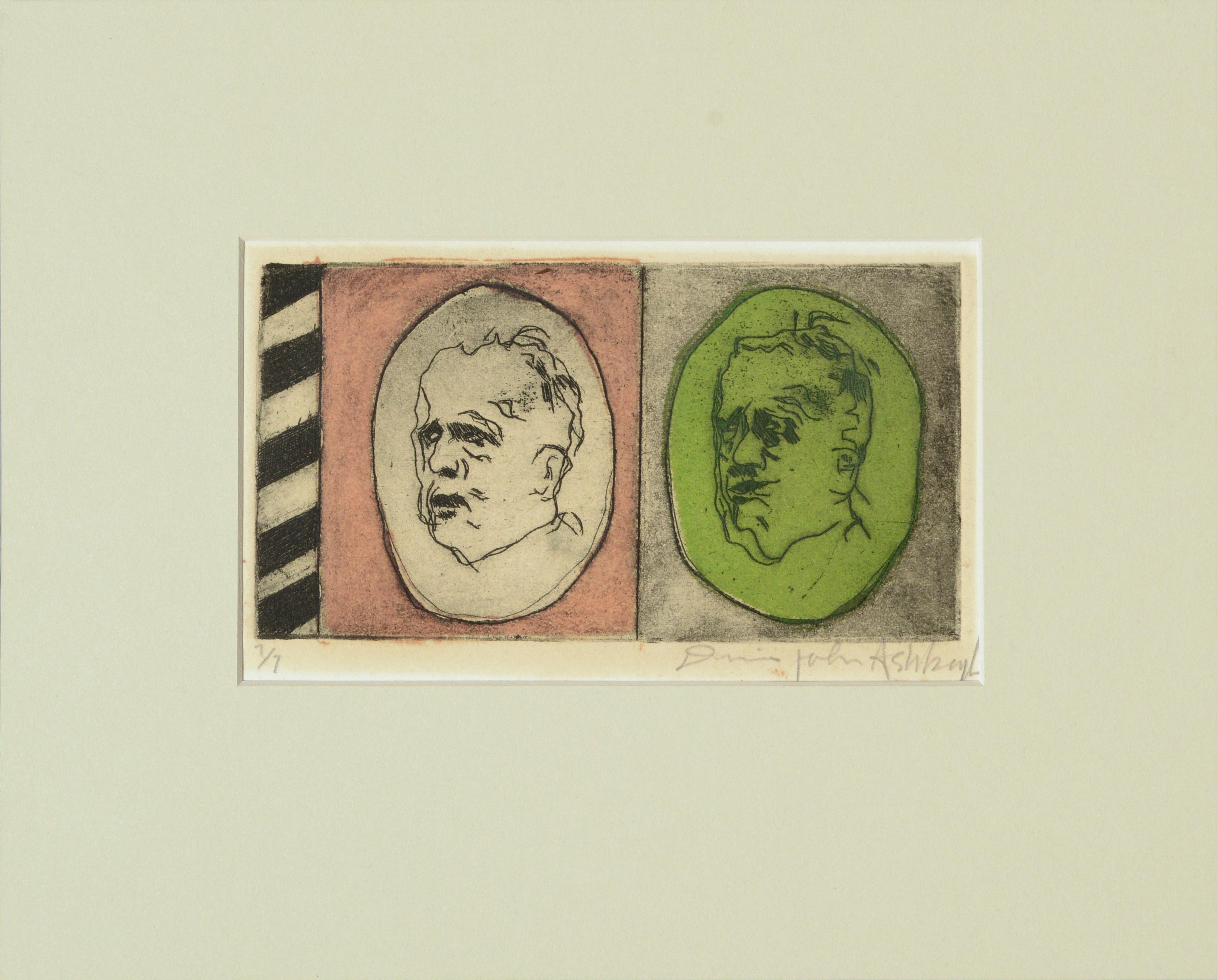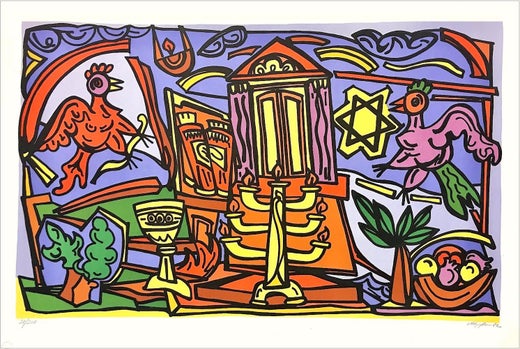Items Similar to Large Venezuelan Jewish Modernist Lithograph Menorah Judaica
Want more images or videos?
Request additional images or videos from the seller
1 of 8
Marius SznajdermanLarge Venezuelan Jewish Modernist Lithograph Menorah Judaica
About the Item
Marius Sznajderman was a painter, printmaker and scenic designer living and working in the United States.
Born in Paris, France in 1926 his Jewish parents had migrated to France from Poland in 1923. In November 1942 the family fled Nazi-occupied France for Spain before settling in Caracas, Venezuela. He attended the School of Fine Arts in Caracas where his teachers included illustrator Ramon Martin Durban, scenic designer Charles Ventrillon-Horber and painter Rafael Monasterios. and immigrated to the United States in 1949, where he received a Bachelor of Fine Arts and Master of Fine Arts from Columbia University in New York. He settled in Hackensack, New Jersey, where he lived and had a studio for more than 50 years before moving to Amherst, Massachusetts in 2015. His work, which includes painting, prints and collages, as well as set designs, is in more than 45 museum and public institution collections in the United States, Latin America and Israel. He held more than 40 solo exhibitions at galleries and museums and participated in more than 75 group shows around the globe.
He helped found the Taller Libre de Arte, an experimental workshop for the visual arts, sponsored by the Ministry of Education. The Taller Libre de Arte was a center for young artists to work and to meet with critics and intellectuals to discuss avant-garde ideas and artistic trends from Europe and Latin America. Among the notable artists who participated in the Taller Libre de Arte were Ramón Vásquez Brito, Carlos González Bogen, Luis Guevara Moreno, Mateo Manaure, Virgilio Trómpiz, Alirio Oramas, Dora Hersen, Alejandro Otero, Jesús Rafael Soto, Pascual Navarro, Aimée Battistini, José Fernández Díaz, Narciso Debourg, Oswaldo Vigas and Perán Erminy.
Sznajderman’s early works as a student and young artist showed the influence of Cubism and Expressionism with subject matter ranging from figures to still life to Venezuelan landscapes. His work often explored Latin American themes, art and architecture.
In 1948 Sznajderman was awarded the art student’s prize for a watercolor in the annual National Gallery exhibit. In 1949 Sznajderman had a solo exhibition at the Taller Libre de Arte. The exhibit catalogue was written by Sergio Antillano, a prominent Venezuelan writer and critic.
That same year, Sznajderman immigrated to the United States to attend Columbia University, where he studied with scenic designer J. Woodman Thompson and printmaker Hans Alexander Mueller. He received a Bachelor of Science degree with a major in scenic design in 1953, after which he was drafted into the U.S. Army. In the military he worked as an artist-illustrator, completing his service in 1955. He returned to Columbia on the G.I Bill to attend Teachers College, where he received a Master of Fine Arts in art education.
During the 1950s Sznajderman created set designs for Circle in the Square Theatre, the French Art Theatre and the Felix Fibish Dance Company, all in New York. By the late 1950s, however, his focus was shifting to fine arts and teaching.
In 1960 Sznajderman was among the three founders, along with painters Sam Weinik and Ben Wilson, of the Modern Artists Guild (MAG), an association of modern artists working in northern New Jersey. Among the artists who were early members of MAG were Esther Rosen, Alexandra Merker, Erna Weill, Jerry Goldman, Lillian Marzell and Evelyn Wilson.
In the 1950s, 1960s and 1970s, in addition to painting and printmaking, Sznajderman taught art, art history and design at a number of institutions including New York University, the School of Visual Arts, Fairleigh Dickinson University and the Ridgewood (N.J.) School of Art. He also taught art in New Jersey public schools under federal and state grants. During this period, Sznajderman’s work ranged from drawings, woodcuts and lithographs to watercolor and acrylic paintings and collages. He produced still life, figures, landscapes and seascapes. Inspirations included Venezuelan remembrances, culture and folklore; Mexican art and pre-Columbian imagery; as well as architecture and theater. Other works have been inspired by Greek mythology and the Commedia dell’arte. Contemporary events, such as the Vietnam War and the assassination of the Rev. Martin Luther King, Jr., also inspired some works.
From 1974 to 1983 Sznajderman served as director of Galeria Venezuela in New York City for the National Council of Culture and Fine Arts of Venezuela (CONAC) while continuing to paint and exhibit. From 1980 to 1986 he oversaw the selection and coordination of the international editions of prints for AGPA (Actualidad Grafica – Panamericana), a project of the Latin American Container Corporation of America (later Smurfit Carton de Venezuela).
Throughout his career, Sznajderman has also explored Jewish themes, including works in remembrance of the Holocaust. In 1988 he produced a limited-edition print, in collaboration with his uncle, the Yiddish journalist and author S.L. Shneiderman, on the occasion of Shneiderman’s 80th birthday. The print featured a 1938 poem by Shneiderman, “Elegy for My Shtetl,” written in Yiddish. The Yiddish text for the print was typeset using the last linotype machine used to print the New York-based Yiddish newspaper, The Forward. In 1989 he designed and supervised the production of a Holocaust memorial monument for Temple Beth El in Hackensack, New Jersey. Other works have explored Nazi concentration and extermination camps, the Vichy government and the Holocaust in France.
For many years Sznajderman had a deep friendship and intimate creative relationship with Venezuelan painter Oswaldo Vigas. In 1987, following a trip of the two families to the Venezuelan Andes, a two-person show of landscapes by Sznajderman and Vigas was held at the venerable Ateneo de Caracas, Galeria los Espacios Calidos.
In 1991 the Contemporary Art Museum of Caracas produced a retrospective exhibit of Sznajderman’s work.
In 2001 Sznajderman began a collages and collage constructions series using Yiddish as a leitmotif. A selection of the works were exhibited at the Yiddish Book Center, Amherst, Massachusetts in 2005-2006.
In 2005, Venezuelan poet Hugo Brett Figueroa published the book "Scargot" with illustrations by Sznajderman. Sznajderman also illustrated the 1993 book “Who Were the Pre-Columbians?” by Bernard Barken Kaufman and “Magicismos,” a book of poems by the Venezuelan poet Enrique Hernandez D’Jesus, published in 1989.
In 2007, Warsaw Ghetto Revolt mural project and a Nazi concentration camp woodcut series created in 1958 and 1959, was exhibited at the Puffin Cultural Forum in Teaneck, New Jersey.[8] In 2011 and 2012 he produced the “Yanaka” series of collages on paper and a large collage construction using Chiyogami - traditional Japanese printed paper - purchased in 1990 in Tokyo.
In 2011 Sznajderman created seven collages using unauthorized lithographs by Salvador Dali as material. The collages were reproduced in a limited-edition booklet titled “Dali, Dumas and Me.” The booklet described a series of events involving the late painter and printmaker Jorge Dumas, who had printed the Dali lithographs. The booklet was presented in 2013 during a solo exhibit by Sznajderman in New York City at Chashama Exhibit Space.
More recently, Sznajderman created a series of print-collages composed from early serigraphs produced in the 1960s. He continued to work and exhibit until the final weeks of his life.
Permanent Collections and Exhibitions
Sznajderman's work is represented in the permanent collections of more than 45 museums and institutions, primarily in the United States but also in Europe, Latin America and Israel. They include the Smithsonian Institution, the Library of Congress, Instituto Nacional de Bellas Artes y Literatura in Mexico City, Museo de Bellas Artes (Caracas), the Museum of Jewish Heritage in New York, the Cincinnati Art Museum, the Simon Wiesenthal Center, the Birmingham Civil Rights Institute, the Irish Museum of Modern Art in Dublin and Yad Vashem in Jerusalem.
- Creator:Marius Sznajderman (1926 - 2018, American, French)
- Dimensions:Height: 21.75 in (55.25 cm)Width: 29.75 in (75.57 cm)
- Medium:
- Movement & Style:
- Period:
- Condition:very minor creasing at margins.
- Gallery Location:Surfside, FL
- Reference Number:1stDibs: LU38212986472
Marius Sznajderman
Born in Paris in 1926, Marius Sznajderman escaped with his parents from France in November of 1942 and lived in Venezuela until 1949, at which time he moved to the United States. He studied at the Museum of Fine Arts in Caracas and Columbia University. In Caracas, he was a founding member of Taller Libre de Arte. In his 40 years as an artist, he has had numerous one-man shows in the US and South America, and his work is in the permanent collections of many important museums.
About the Seller
4.9
Platinum Seller
These expertly vetted sellers are 1stDibs' most experienced sellers and are rated highest by our customers.
Established in 1995
1stDibs seller since 2014
1,565 sales on 1stDibs
Typical response time: 1 hour
- ShippingRetrieving quote...Ships From: Surfside, FL
- Return PolicyA return for this item may be initiated within 3 days of delivery.
More From This SellerView All
- Pablo Picasso Estate Hand Signed Cubist Lithograph Abstract Woman Portrait TeteBy (after) Pablo PicassoLocated in Surfside, FLPablo Picasso (after) "Femme Assise dans un Fauteuil" limited edition print on Arches paper, Hand signed by Marina Picasso lower right and numbered 284/500 lower left From the estat...Category
20th Century Modern Abstract Prints
MaterialsLithograph
- French Modernist Mourlot Lithograph Vintage Air France Poster Roger BezombesBy Roger BezombesLocated in Surfside, FLVintage French Travel Poster, Air France Roger Bezombes (1913-1994) French Bezombes was a painter, sculptor, medalist, and designer. He studied in Paris, at the École des Beaux-Arts, and was much influenced by his friendship with Maurice Denis. Heavily influenced by surrealism, He worked principally as a painter, adopting the saturated Fauvist colors of Henri Matisse in landscapes and figure studies often based on observation of “exotic” cultures, notably Mediterranean and North African. Constrained, because a very young orphan, to all kinds of professions which provide him with the material means to devote himself to painting - he participated in 1930 in the installation of the exhibition of the Bauhaus at the Grand Palais-, Roger Bezombes is student of the National School of Fine Arts in Paris. (Ecole des Beaux Artes) He was trained in the art of fresco by Paul Baudoüin, René Barotte nonetheless restores that the young man's preference goes to the practice of "truancy" which he uses to make copies at the Louvre Museum. It’s the time when Paul Gauguin’s paintings, Vincent Van Gogh and Henri Matisse are revealed to him by Maurice Denis with whom he will remain close until his accidental death, painting him on his funeral bed on November 14, 1943. He executed surrealist tapestry designs for Aubusson and Gobelin tapestries, posters (winning the Grand Prix de l'Affiche Francaise in 1984), costumes and sets for ballets at the Metropolitan Opera House in New York, reliefs and murals. In 1965 he took up medal-making, expressing in his numerous metallic works for the Paris Mint that obsession with found objects which is also evident in his large-scale sculpture and in his posters. He designed posters for Air France and for the French national railways. Roger Bezombes went to Africa for the first time in 1936 thanks to a travel grant and received the same year the second grand prize of Rome . In 1937 he traveled around Morocco where he became friends with Albert Camus. The year 1938 offered him both his first solo exhibition at the Charpentier gallery in Paris with paintings and gouaches on the theme of Morocco and the attribution of the national grand prize for the arts, earning him a great journey which , from Dakar to Algiers , takes it through Chad , Tamanrasset and Hoggar. Roger Bezombes became a professor at the Julian Academy in 1950. For him, 1951 was the year of a trip to Greece and the year where he began his relationship with tapestry work. Roger Bezombes visited Israel in 1953, Tunisia and Egypt in 1954. He was appointed official painter of the Navy in 1955. Pierre Mazars analyzes that “after a period where we notice the influence of Van Gogh and GeorgesBraque, particularly in his landscapes of Provence, he came to a more schematic writing, the colored spots and the thicknesses of material taking more of importance as the subject. He even performed composite works, half-watercolors, half-pasted papers, in which he incorporated pieces of newspapers”. He was elected titular to the Academy of Overseas Sciences in 1978. "The range of Bezombes' talent forms is remarkable,” writes Lynne Thornton, “ranging from paintings, murals, travel posters, tapestry cartons, book illustrations, monumental ceramic decorations, ballet and theater sets, totem sculptures, sculpture objects, jewelry and medallions”. He was part of the mid century mod School of Paris that included Leon Zack, Bernard Lorjou, Paul Augustin Aizpiri, Gabriel Godard, Michel Henry, Hans Erni, Bengt Lindstrom, Alfred Manessier, Andre Hambourg, Raymond Legueult and Jean Rigaud. Select Solo Exhibitions: 1938: Galerie Charpentier, Paris 1950, '53, '55, '57: Galerie Andre Weil, Paris 1953:Wildenstein Gallery, London 1954: Institut Francais, Cologne 1956: Galerie Matarasso, Nice 1957: Horn Gallery, Luxembourg; Guilde de la Gravure, Paris 1958: Denys-Puech Museum, Rodez 1962: Musee de l'Athenee, Geneva; Chateau Grimaldi, Cagnes-sur-Mer 1966: Galerie des Ponchettes, Nice 1967: Galerie Martel, Montreal 1968: Romanet-Vercel Gallery, New York; Reattu Museum, Arles; Le Corbusier Center, Firminy 1969: Galerie Philippe...Category
1980s Modern Abstract Prints
MaterialsOffset, Lithograph
- French Modernist Mourlot Lithograph Vintage Air France Poster Roger BezombesBy Roger BezombesLocated in Surfside, FLVintage French Travel Poster, Air france Roger Bezombes (1913-1994) French Bezombes was a painter, sculptor, medalist, and designer. He studied in Paris, at the École des Beaux-Arts, and was much influenced by his friendship with Maurice Denis. Heavily influenced by surrealism, He worked principally as a painter, adopting the saturated Fauvist colors of Henri Matisse in landscapes and figure studies often based on observation of “exotic” cultures, notably Mediterranean and North African. Constrained, because a very young orphan, to all kinds of professions which provide him with the material means to devote himself to painting - he participated in 1930 in the installation of the exhibition of the Bauhaus at the Grand Palais-, Roger Bezombes is student of the National School of Fine Arts in Paris. (Ecole des Beaux Artes) He was trained in the art of fresco by Paul Baudoüin, René Barotte nonetheless restores that the young man's preference goes to the practice of "truancy" which he uses to make copies at the Louvre Museum. It’s the time when Paul Gauguin’s paintings, Vincent Van Gogh and Henri Matisse are revealed to him by Maurice Denis with whom he will remain close until his accidental death, painting him on his funeral bed on November 14, 1943. He executed surrealist tapestry designs for Aubusson and Gobelin tapestries, posters (winning the Grand Prix de l'Affiche Francaise in 1984), costumes and sets for ballets at the Metropolitan Opera House in New York, reliefs and murals. In 1965 he took up medal-making, expressing in his numerous metallic works for the Paris Mint that obsession with found objects which is also evident in his large-scale sculpture and in his posters. He designed posters for Air France and for the French national railways. Roger Bezombes went to Africa for the first time in 1936 thanks to a travel grant and received the same year the second grand prize of Rome . In 1937 he traveled around Morocco where he became friends with Albert Camus. The year 1938 offered him both his first solo exhibition at the Charpentier gallery in Paris with paintings and gouaches on the theme of Morocco and the attribution of the national grand prize for the arts, earning him a great journey which , from Dakar to Algiers , takes it through Chad , Tamanrasset and Hoggar. Roger Bezombes became a professor at the Julian Academy in 1950. For him, 1951 was the year of a trip to Greece and the year where he began his relationship with tapestry work. Roger Bezombes visited Israel in 1953, Tunisia and Egypt in 1954. He was appointed official painter of the Navy in 1955. Pierre Mazars analyzes that “after a period where we notice the influence of Van Gogh and GeorgesBraque, particularly in his landscapes of Provence, he came to a more schematic writing, the colored spots and the thicknesses of material taking more of importance as the subject. He even performed composite works, half-watercolors, half-pasted papers, in which he incorporated pieces of newspapers”. He was elected titular to the Academy of Overseas Sciences in 1978. "The range of Bezombes' talent forms is remarkable,” writes Lynne Thornton, “ranging from paintings, murals, travel posters, tapestry cartons, book illustrations, monumental ceramic decorations, ballet and theater sets, totem sculptures, sculpture objects, jewelry and medallions”. He was part of the mid century mod School of Paris that included Leon Zack, Bernard Lorjou, Paul Augustin Aizpiri, Gabriel Godard, Michel Henry, Hans Erni, Bengt Lindstrom, Alfred Manessier, Andre Hambourg, Raymond Legueult and Jean Rigaud. Select Solo Exhibitions: 1938: Galerie Charpentier, Paris 1950, '53, '55, '57: Galerie Andre Weil, Paris 1953:Wildenstein Gallery, London 1954: Institut Francais, Cologne 1956: Galerie Matarasso, Nice 1957: Horn Gallery, Luxembourg; Guilde de la Gravure, Paris 1958: Denys-Puech Museum, Rodez 1962: Musee de l'Athenee, Geneva; Chateau Grimaldi, Cagnes-sur-Mer 1966: Galerie des Ponchettes, Nice 1967: Galerie Martel, Montreal 1968: Romanet-Vercel Gallery, New York; Reattu Museum, Arles; Le Corbusier Center, Firminy 1969: Galerie Philippe...Category
1980s Modern Abstract Prints
MaterialsLithograph, Offset
- Fernand Leger Colorful Modernist Drawing Limited Edition Serigraph LithographBy (after) Fernand LégerLocated in Surfside, FLSerigraph, from ''Album of Ten Serigraphs'' (1954-55), by Fernand Leger (French 1881-1955), signed and dated in plate lower right, printed by Jean Bruller, distributed by Galerie International de la Gravure, Paris (Sapphire E8), sheet: 22''H x 15''W, "Chevreuse Aout", Serigraph in colors on Arches paper, F. Leger embossed blindstamp, Numbered in pencil and bears the embossed stamp. Joseph Fernand Henri Léger (French 1881 – 1955) was a French painter, sculptor, and filmmaker. In his early works he created a personal form of cubism which he gradually modified into a more figurative, populist style. His boldly simplified treatment of modern subject matter has caused him to be regarded as a forerunner of pop art. Léger was born in Argentan, Orne, Lower Normandy, where his father raised cattle. Fernand Léger initially trained as an architect from 1897 to 1899, before moving in 1900 to Paris, where he supported himself as an architectural draftsman. After military service in Versailles, Yvelines, in 1902–1903, he enrolled at the School of Decorative Arts after his application to the École des Beaux-Arts was rejected. He nevertheless attended the Beaux-Arts as a non-enrolled student, spending what he described as "three empty and useless years" studying with Gérôme and others, while also studying at the Académie Julian. He began to work seriously as a painter only at the age of 25. At this point his work showed the influence of impressionism, as seen in Le Jardin de ma mère (My Mother's Garden) of 1905, one of the few paintings from this period that he did not later destroy. A new emphasis on drawing and geometry appeared in Léger's work after he saw the Cézanne retrospective at the Salon d'Automne in 1907. In 1909 he moved to Montparnasse and met Alexander Archipenko, Jacques Lipchitz, Marc Chagall, Joseph Csaky and Robert Delaunay. In 1910 he exhibited at the Salon d'Automne in the same room (salle VIII) as Jean Metzinger and Henri Le Fauconnier. In his major painting of this period, Nudes in the Forest, Léger displays a personal form of Cubism that his critics termed "Tubism" for its emphasis on cylindrical forms. In 1911 the hanging committee of the Salon des Indépendants placed together the painters identified as 'Cubists'. Metzinger, Albert Gleizes, Le Fauconnier, Delaunay and Léger were responsible for revealing Cubism to the general public for the first time as an organized group. The following year he again exhibited at the Salon d'Automne and Indépendants with the Cubists, and joined with several artists, including Le Fauconnier, Metzinger, Gleizes, Francis Picabia and the Duchamp brothers, Jacques Villon, Raymond Duchamp-Villon and Marcel Duchamp to form the Puteaux Group—also called the Section d'Or (The Golden Section). Léger's paintings, from then until 1914, became increasingly abstract. Their tubular, conical, and cubed forms are laconically rendered in rough patches of primary colors plus green, black and white, as seen in the series of paintings with the title Contrasting Forms. Léger made no use of the collage technique pioneered by Georges Braque and Pablo Picasso.As an enthusiast of the modern, Léger was greatly attracted to cinema, and for a time he considered giving up painting for filmmaking. In 1924, in collaboration with Dudley Murphy, George Antheil, and Man Ray, Léger produced and directed the iconic and Futurism-influenced film Ballet Mécanique (Mechanical Ballet). Neither abstract nor narrative, it is a series of images of a woman's lips and teeth, close-up shots of ordinary objects, and repeated images of human activities and machines in rhythmic movement. In collaboration with Amédée Ozenfant he established a free school where he taught from 1924, with Alexandra Exter and Marie Laurencin. He produced the first of his "mural paintings", influenced by Le Corbusier's theories. His varied projects included book illustrations, murals, stained-glass windows, mosaics, polychrome ceramic sculptures, and set and costume designs. He was active as a teacher for many years, first at the Académie Vassilieff in Paris, then in 1931 at the Sorbonne, and then developing his own Académie Fernand Léger, which was in Paris, then at the Yale School of Art and Architecture (1938–1939), Mills College Art Gallery in Oakland, California during 1940–1945, before he returned to France. Among his many pupils were Hananiah Harari, Asger Jorn, Michael Loew, Beverly Pepper, Marcel Mouly, Louise Bourgeois, Tsuguharu Foujita, Sam Francis, Serge Gainsbourg, Hans Hartung, Florence Henri, Asger Jorn, William Klein, Maryan, Jules Olitski, Erik Olson...Category
1950s Modern Abstract Prints
MaterialsLithograph
- Modernist Figurative Pop Art Etching and Aquatint "the Artist" Michael MazurBy Michael MazurLocated in Surfside, FLMichael Mazur "The Artist" Hand signed and editioned from the edition of 50 1967 Michael Burton Mazur (1935-August 18, 2009) was an American artist who was described by William Grimes of The New York Times as "a restlessly inventive printmaker, painter, and sculptor." Born and raised in New York City, Mazur attended the Horace Mann School. He received a bachelor's degree from Amherst College in 1958, then studied art at Yale. Mazur first gained notice for his series of lithographs and etchings of inmates in a mental asylum, which resulted in two publications, "Closed Ward" and "Locked Ward." Over the years, he worked in printmaking and painting. His series of large-scale prints for Dante's Inferno won critical acclaim, and were the subject of a traveling exhibition organized by the University of Iowa in 1994. Later he concentrated on creating large, lyrical paintings which make use of his free, gestural brushwork and a varied palette. Some of these paintings were seen in an exhibition of 2002 at Boston University, "Looking East: Brice Marden, Michael Mazur, and Pat Steir." (See also Susan Danly, "Branching: The Art of Michael Mazur," 1997). The Museum of Fine Arts, Boston, has acquired a definMichael Mazur received a B.A. from Amherst College in 1957, studying in his senior year at the Accademia di Belle Arti in Florence, Italy. He went on to earn both a B.F.A. and an M.F.A. from the Yale School of Art and Architecture in 1961. Mazur's first teaching job was at the Rhode Island School of Design from 1961 to 1964. He was awarded a Guggenheim Foundation fellowship for 1964–65. From 1965 to 1976, he taught at Brandeis University, and from 1976 to 1978 at Harvard University. As an artist, teacher, and writer, Mazur has been active in reviving the monotype process. He contributed an essay to the pioneering exhibition catalogue The Painterly Print, published by the Metropolitan Museum of Art in 1980. Mazur recently chaired the New Provincetown Print...Category
Early 2000s American Modern Abstract Prints
MaterialsLithograph, Screen
- Georges Braque Bouquet de Fleurs Lithograph Bold Blue Hand Signed Ltd Ed PrintBy Georges BraqueLocated in Surfside, FLGeorges Braque (French, 1882-1963) Bouquet de Fleurs Lithograph in colors, 1957. Published by Maeght, printed by Mourlot, Paris, France Numbered 166/300 and hand signed in pencil. ...Category
20th Century Modern Figurative Prints
MaterialsLithograph
You May Also Like
- Window on Another Dimension, signed/n lithograph by Picasso's famous mistressBy Françoise GilotLocated in New York, NYFrançoise Gilot Window on Another Dimension, 1981 Lithograph on Arches mould made Johannot paper Signed and numbered in graphite pencil; also bears artist's monogram with date, edition of 60 Frame included: floated in the original vintage frame Measurements: Framed 30 inches vertical by 22 inches horizontal by .75 inches depth Artwork: 27.25 inches by 19.75 inches Francoise Gilot was not just Picasso's muse; she was an accomplished artist in her own right, and at age 100, the New York Times dubbed her the art world's latest "It Girl".! Signed and numbered in graphite pencil; also bears artist's personal monograph with date. Held in original vintage frame under plexiglass. Charmingly, there is a sticker label on the back of the frame, from the "Picasso Gallery Custom Framing" in D.C. This silkscreen is based upon Gilot's eponymous painting, also done in 1981 Excerpt from Alan Riding's 2023 New York Times obituary on Gilot: " Françoise Gilot, an accomplished painter whose art was eclipsed by her long and stormy romantic relationship with a much older Pablo Picasso, and who alone among his many mistresses walked out on him, died on Tuesday at a hospital in Manhattan. She was 101...But unlike his two wives and other mistresses, Ms. Gilot rebuilt her life after she ended the relationship, in 1953, almost a decade after it had begun despite an age difference of 40 years. She continued painting and exhibiting her work and wrote books. In 1970, she married Jonas Salk, the American medical researcher who developed the first safe polio vaccine, and lived part of the time in California. Still, it was for her romance with Picasso that the public knew her best, particularly after her memoir, “Life with Picasso,” written with Carlton Lake, was published in 1964. It became an international best seller, and so infuriated Picasso that he broke off all contact with Ms. Gilot and their two children, Claude and Paloma Picasso. Ms. Gilot’s frank and often-sympathetic account of their relationship — she dedicated the book “to Pablo” — provided much of the material for the 1996 Merchant-Ivory movie, “Surviving Picasso,” in which she was played by Natascha McElhone, with Anthony Hopkins as Picasso. If Ms. Gilot’s book sold well, so has her art. With her work in more than a dozen museums, including the Metropolitan Museum of Art and the Museum of Modern Art in New York and the Centre Pompidou in Paris, her paintings fetched increasingly higher prices well into her later years. As recently as June 2021, her painting “Paloma à la Guitare” (1965), a blue-toned portrait of her daughter, sold for $1.3 million in an online auction by Sotheby’s. That surpassed her previous record price, $695,000, paid for “Étude bleue,” a 1953 portrait of a seated woman, at a Sotheby’s auction in 2014.. And in November 2021, her abstract 1977 canvas “Living Forest” sold for $1.3 million as part of a retrospective of her work at Christie’s in Hong Kong. Lisa Stevenson, the head of curated sales for Sotheby’s in London, told ARTnews after the 2021 auction, “It isn’t commonly known that Gilot’s commitment to art was present long before her relationship with Pablo Picasso, and she was sadly often left in his shadow.”.. Marie Françoise Gilot was born into a prosperous family on Nov. 26, 1921, in Neuilly-sur-Seine, a suburb of Paris, the only child of Emile Gilot, an agronomist and chemical manufacturer, and Madeleine Renoult-Gilot. Her 19th-century ancestors had owned a couturier house of fashion whose clientele included Eugenia, the wife of Emperor Napoleon III. Marie Françoise was drawn to art from an early age, tutored by her mother, who had studied art history, ceramics and watercolor painting. Her father, however — recalled by Ms. Gilot as an authoritarian who had forced her to write with her right hand, though she was left-handed — had other ideas. Envisioning a career in science or the law for his daughter, he persuaded her to enroll at the University of Paris, where she received her bachelor’s degree in 1938 at age 17. She went on to study at the Sorbonne and the British Institute in Paris and receive a degree in English literature from Cambridge University. As war crept closer to France in 1939, her father sent her to the city of Rennes, northwest of Paris, to enroll in law school. All the while she continued working on her paintings. Then came the German occupation of Paris, in June 1940, and she joined other students in an anti-German protest march at the Arc de Triomphe. In a clash with the French and German authorities, Ms. Gilot was arrested, briefly detained and put under watch. “From day one, we were not the kind of people who would become collaborators,” she said of her family. She continued her law studies at the University of Paris, but after taking her second-year examinations, in June 1941, she lost interest and abandoned the field, deciding to devote herself to art. She began private lessons with a fugitive Hungarian Jewish painter, Endre Rozsda, and attended classes at the Académie Julian, which numbered Matisse...Category
1980s Modern Abstract Prints
MaterialsGraphite, Lithograph, Pencil
- Two Faces, Modern Self-Portrait Lithograph of the Artist Aging in Pink & GreenBy Dennis John AshbaughLocated in Soquel, CALimited edition hand signed lithograph featuring two consecutive modern portraits of faces with varying degrees of abstraction, in pink and green, by Dennis john Ashbaugh (American, b. 1946). Numbered "7/7" in the lower-left corner. Signed "Dennis John Ashbaugh" in the lower right corner. Presented in a new tan mat with foam core backing. Unframe. Image size: 4"H x 6.75"W. Some toning yellowing at mat opening. Dennis John Ashbaugh (American, b. 1946) was born in Red Oak, Iowa, and attended California State University at Fullerton, receiving his MA in 1969. Ashbaugh has spent most of his career in New York City. In 1992, he collaborated with William Gibson, a fiction writer, and with publisher Kevin Begos on a book, Agrippa, meaning 'book of the dead'. Exhibition venues include the Metropolitan Museum of Art in New York City, the P.S.1 Contemporary Art Center, the Seattle Art Museum, and the Whitney Museum of American ArtPublic collections holding his work include the Hirshhorn Museum, the Museum of Fine Arts, Houston, the Los Angeles County Museum of Art, and the New York Metropolitan. He received a Guggenheim Fellowship. Ashbaugh lives in a trim frame house in Flamingo Park...Category
1970s Modern Figurative Prints
MaterialsPaper, Ink, Lithograph
- DEMOCRATIC PARTY HUMAN RIGHTS DINNERBy Robert RauschenbergLocated in Aventura, FLOffset lithograph on hodgkins handmade paper. Hand signed and numbered in pencil by the artist. Certificate of authenticity included. Edition of 100. Framed. All reasonable offers w...Category
1980s Modern Abstract Prints
MaterialsHandmade Paper, Lithograph, Offset
- Deux PersonnagesBy André MassonLocated in Missouri, MOSigned Lower Right Numbered Lower Left 166/200 Framed Size: 33 x 25 inches Andre Masson was born in Balagne, France on January 4, 1896. He was an engraver, sculptor, stage designer...Category
1960s Modern Figurative Prints
MaterialsLithograph
- Profil RoseBy André MassonLocated in Missouri, MOSigned Lower Right Numbered 61/200 Sight Size: 27.5 x 21.5 Framed Size: 31.5 x 24.5 Andre Masson was born in Balagne, France on January 4,1896. He was an engraver, sculptor, stage d...Category
1960s Modern Figurative Prints
MaterialsLithograph
- Some People TogetherBy Karel AppelLocated in New York, NYSome People Together, 1974 Hand-signed and dated in pencil Color lithograph and screenprint Sheet 22 x 29 3/4 inches; 559 x 756 mm. Edition 110Category
1970s Modern Abstract Prints
MaterialsLithograph, Screen
Recently Viewed
View AllMore Ways To Browse
French Modernist Designers
Jewish Large
Large Jewish Art
Jewish Large Paintings
Marius Marius
Marius And Marius
Architectural Drawing Modernist
Spanish Jewish
Jesus Large
Vintage Large Container
Judaica Lithograph
45 Three Modern Vintage
Contemporary Judaica
Cubism Still Life 20th Century
Fine Art Judaica
French Judaica
Jewish Heritage
Woodcut Modernist
